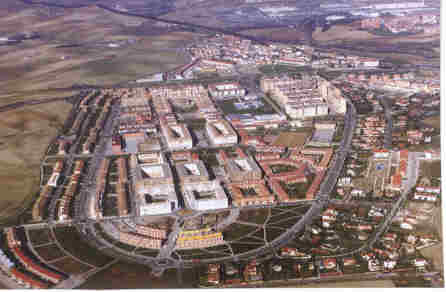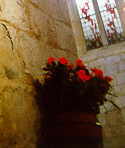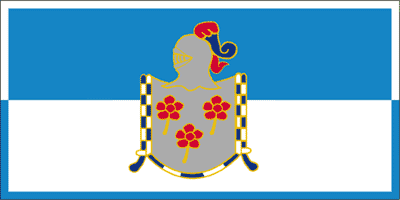Zizur
Mayor, is a village near Pamplona, located in a rural environment that has
evolved until becoming a small great city in the last years, with
an excellent quality of life...
Historical
category: Place
Judicial
Party: Pamplona
Geographical
district: Cuenca
of Pamplona
Extension:
5,5
km2
Altitude
in urban nucleus:
470
m
Gentile: Zizurtarra
Inhabitants:
12.906
habitants
Population:
2.346
habitants/Km2
Coordinated
of situation:
Limits
to the North with term of Barañain, Northwest with term of Arazuri, Northeast
with term of Pamplona (Etxabakoitz), South with terms of Galar and Cizur Menor,
Southeast with term of Cizur Menor and West with term of Gazolaz

It is located on a slope (470 m.
altitude), separated from the plateau of Barañain-Eulza by the depression of
the river Elorz, and that it is prolonged towards the West by the mount of
Gazolaz.
It
limits with the terms of Barañain and Eulza to the North, Arazuri on the
Northwest, Gazolaz on the West, Galar on the South, Cizur Menor on the Southeast
and East and Etxabakoitz (Pamplona) on the Northwest.
We
are located before a landscape of smoothly wavy relieves and of small crests (Guenduláin,
540 m.), near the Sierra of the “Perdón”, of 1037m. High.
The
river Elorz crosses the term of
Zizur Mayor, before ending in the river Arga.
The vegetation consists of a mixed forest of oaks and pines, where the man's
hand has acted until its last consequences, being configured today in
an agrarian landscape of cereal fields and an area of forests located to
the northwest on the term and composed by pine halepinses or repopulation pine
groves.


The
climate of Zizur Mayor is sub Atlantic, just as they demonstrate the annual data
, with 1000 mm on precipitations in 110-135 days, temperatures stockings 10º-13º,
around two months of summery aridity, winters colds and humid and 650-725 mm of
evaporation.
The first historical news date of the year 1092. Zizur Mayor belonged to the Val of Etxauri until the year 1846, and later it passed to be part of the Cendea of Cizur, from which it was segregated and formed as own City council in the year 1993.

In
the XIII Century the Hospital of San Juan possessed
most of the territory of Zizur Mayor. In the year 1366 the population was
composed by 10 clergymen, 2 noblemen and 3 farmers.
The
population among the XVI and XIX centuries didn't experience a great variation.
In this time, administratively, they were governed by a mayoral and a jury,
positions that were renovated
annually. The neighbours congregated in concejos and bacarres", to bell
touched and called the judges, when
they demanded the necessities. The
jury was the one in charge of the civil and military business.
In
the XVII Century the town paid a pecha or annual contribution of 24 cahíces (measure
of capacity for arid, of different capacity according to the regions) of wheat
and six of barley, also, food for the abbot and eleven companions in its visits
to Pamplona, as well as straw and barley for its mounts.
Zizur,
was part of the Cendea of Cizur next to the Town councils of Astrain, Zizur
Menor, Gazolaz, Guendulain, Larraya-Eriete, Muru-Astrain, Paternain , Sagües,
Undiano and Zariquiegui, until the year 1993, in which it was constituted as own
City council.
The
flag of Zizur Mayor, dates of the year 2001, it was approved by the Full of the
City council of Zizur Mayor in the celebrated Session that
was the 30 of March of 2001.
Investigations
were carried out to verify that there was not any precedent of flag , made of the shield of the town and the use of the blue colour.
<<
Flag whose surface is divided by horizontal half, being the superior part of
blue colour (Pantone nº 2925) and the inferior part of white colour, with
border also divided by horizontal half that in the superior part, that of blue
colour, will be white and in the inferior part, that of white colour, will be
blue, of identical tones respectively, with the shield of the town in the centre
of the same one. The shield of the town is the one that officially comes being
used, formed by three roses (red) prepared in triangle bigger envelope bottom or
silver field, with gentleman's helmet with feather of feathers in blue and red (Pantone
nº 485) and a border in blue and silver >


The
incidence of the Primary Sector in the occupation of Zizur Adult's neighbours is
very little, not reaching the active population's 1%.
The
agricultural sector is the only asset, having already disappeared the dedication
to the cattle raising some years ago.
The
agriculture is based on cereal products like wheat, barley and it trenches,
worked in big surfaces thanks to the concentration it would parcel carried out
in the year 1989. Nevertheless for few years they are come cultivating other
alternative products although in smaller measure as they are: the sunflower, the
pea, the soya and the forage.
The
sector services in the last years have acquired great importance in the
municipality, as much for the variety as for the occupation percentage that
supposes.


The
population of Zizur Mayor, in a great percentage , works in the secondary
sector, but paradoxically the activity is carried out outside of the term of
Zizur Mayor, for two reasons mainly, for caracer this municipality of industrial
polygon and especially for the vicinity of the capital in the one that is the
biggest industrial concentration of Navarrese.
The
City council of Zizur Mayor in its last Revision of the General Plan of Urban
Ordination included an industrial polygon in the denominated place of Arrieta
conformed by the units urban U-3 and U-4.
This
project was paralysed by the Government of Navarrese until the resolution of the
layout of the high-speed train that as it seems it can go very near to the one
mentioned project of the industrial polygon.
The
way to Santiago crosses the
term of Zizur Mayor. The road enters in Zizur Mayor through the Southeast,
through the terms of The Juncal and Sario bordering
the area of Cizur Menor . Today most of the pilgrims like the alternative to the original
road and they choose the itinerary following the national road 111 (Pamplona-Estella),
this can be due to the biggest comfort or for ignorance of the original location.
The road crosses Zizur, and continuous until the town of Astrain, where a
hospital of pilgrims existed until final of last century.

In the track between Pamplona and
Puente la Reina, the Cendea of Zizur
it’s a part of the French Road. Indeed, this route goes by four populations of
the Cendea: Cizur Menor, Guenduláin, Zariquiegui and Astráin.
Foto
11
Facade
of San Andrés Apostle's Church: It occupies the most northeastern point in the
urban nucleus. Of Gothic style (XIV Century)), their plant offers an only ship
with four tracks and the presbytery or apse divided in two more tracts. It
conserves their original spirit in spite of the two lateral chapels added later
on that they make him take the aspect of a plant of Latin cross. In the exterior
it highlights the cover, widened with pointed arch that it rests in capitals of
foliages. This temple, landmark
highlighted in the pilgrimages of the Half Age, National Monument was declared
the 20 of August in 1973. The temple possesses a transition Crucifix to the very
worshipped Gothic, an important goldwork piece, a ciborium of the XVI century
with a transition style between the decorativista of the first rebirth and the
Greco-Roman one of bigger austerity and rigidity, and some rich embroidered
lectern cloths of the XVIII century.
Edgar
Fernández……………4ºB
Asier Pérez…………………..4ºB
Alejandro Del Pino………….4ºB
Andoni Iriarte……………….. 4ºB